
Phallaceae is a family of fungi, commonly known as stinkhorns, within the order Phallales. Stinkhorns have a worldwide distribution, but are especially prevalent in tropical regions. They are known for their foul-smelling, sticky spore masses, or gleba, borne on the end of a stalk called the receptaculum. The characteristic fruiting-body structure, a single, unbranched receptaculum with an externally attached gleba on the upper part, distinguishes the Phallaceae from other families in the Phallales. The spore mass typically smells of carrion or dung, and attracts flies, beetles and other insects to help disperse the spores. Although there is great diversity in body structure shape among the various genera, all species in the Phallaceae begin their development as oval or round structures known as "eggs". The appearance of Phallaceae is often sudden, as gleba can erupt from the underground egg and burst open within an hour. According to a 2008 estimate, the family contains 21 genera and 77 species.

The genus Phallus, commonly known as stinkhorns, is a group of basidiomycetes which produce a phallic, often foul-scented mushroom, from which their name is derived. The genus has a widespread distribution and, according to a 2008 estimate, contains 18 species. They belong to the family Phallaceae in the order Phallales. The best known species is the common stinkhorn.
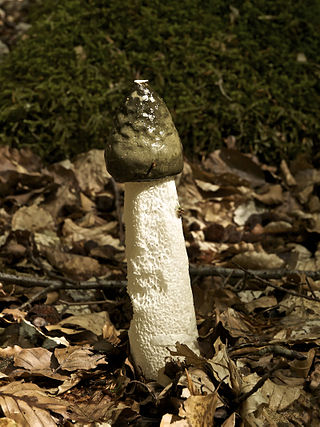
Phallus impudicus, known colloquially as the common stinkhorn, is a widespread fungus in the Phallaceae (stinkhorn) family. It is recognizable for its foul odor and its phallic shape when mature, the latter feature giving rise to several names in 17th-century England. It is a common mushroom in Europe and North America, where it occurs in habitats rich in wood debris such as forests and mulched gardens. It appears from summer to late autumn. The fruiting structure is tall and white with a slimy, dark olive colored conical head. Known as the gleba, this material contains the spores, and is transported by insects which are attracted by the odor—described as resembling carrion. Despite its foul smell, it is not usually poisonous and immature mushrooms are consumed in parts of France, Germany and the Czech Republic.

Phallus ravenelii, commonly known as Ravenel's stinkhorn, is a fungus in the Phallaceae (stinkhorn) family. It is found in eastern North America. Its mushrooms commonly grow in large clusters and are noted for their foul odor and phallic shape when mature. It is saprobic, and as such it is encountered in a wide variety of habitats rich in wood debris, from forests to mulched gardens or sawdust piles in urban areas. It appears from August to October. The fruit body emerges from a pink or lavender-colored egg to form a tall, cylindrical, hollow and spongy white stalk with a bell-shaped cap. The remains of the egg persist as a white to pink or lilac volva at the base of the stalk. The cap is covered in a foul-smelling olive-green spore slime, which attracts insects that help to spread the spores. Sometimes, the cap has a "veil" attached—a thin membrane that hangs underneath. The lack of a roughly ridged and pitted cap differentiates it from the closely related Phallus impudicus. The fungus is named after Henry William Ravenel, a botanist who first discovered it in 1846, though it remained undescribed until 1873. It is considered to be an edible mushroom while in its egg form.
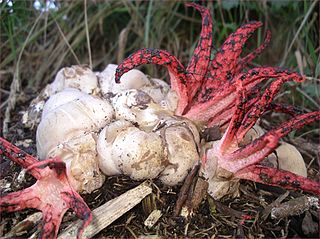
Clathrus is a genus of fungi of the family Phallaceae, the stinkhorn fungi. Mature fruit bodies are covered with olive-brown slimy gleba, containing spores, that attract flies. These fungi are saprobic and are common in mulch.

Phallus rubicundus is a species of fungus in the stinkhorn family. First described in 1811, it has a wide distribution in tropical regions. It has the typical stinkhorn structure consisting of a spongy stalk up to 15 cm (5.9 in) tall arising from a gelatinous "egg" up to 3 cm (1.2 in) in diameter. Atop the stalk is a pitted, conical cap that has a foul-smelling, gelatinous, green spore mass spread over it.

Clathrus archeri, commonly known as octopus stinkhorn or devil's fingers, is a fungus which has a global distribution. This species was first described in 1980 in a collection from Tasmania. The young fungus erupts from a suberumpent egg by forming into four to seven elongated slender arms initially erect and attached at the top. The arms then unfold to reveal a pinkish-red interior covered with a dark-olive spore-containing gleba. In maturity it smells like putrid flesh.

Clathrus ruber is a species of fungus in the family Phallaceae, and the type species of the genus Clathrus. It is commonly known as the latticed stinkhorn, the basket stinkhorn, or the red cage, alluding to the striking fruit bodies that are shaped somewhat like a round or oval hollow sphere with interlaced or latticed branches. The species was illustrated in the scientific literature during the 16th century, but was not officially described until 1729.
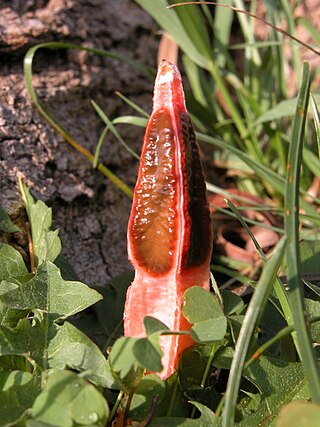
Lysurus mokusin, commonly known as the lantern stinkhorn, the small lizard's claw, or the ribbed lizard claw, is a saprobic species of fungus in the family Phallaceae. The fruit body consists of a reddish, cylindrical fluted stipe that is capped with several "arms". The arms can approach or even close in on each other to form a spire. The gleba—an olive-green slimy spore mass—is carried on the outer surface of the arms. The fruit body has an odor comparable to "fresh dog feces", "rotting flesh", or "sewage" when mature.
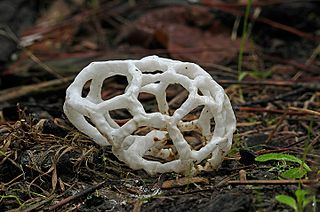
Ileodictyon cibarium is a saprotrophic species of fungus in the family Phallaceae. It is native to Australia and New Zealand, where it is commonly known as the basket fungus or the white basket fungus, alluding to its fruit bodies, shaped like a round or oval ball with interlaced or latticed branches, resembling polyhedra similar to closed fullerenes. Although the immature spherical fruitbodies are reportedly edible, the mature fruit body is foul-smelling and partly covered with a slime layer containing spores (gleba) on the inner surfaces.
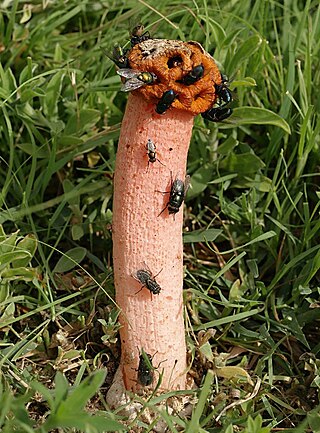
Lysurus periphragmoides, commonly known as the stalked lattice stinkhorn or chambered stinkhorn, is a species of fungus in the stinkhorn family. It was originally described as Simblum periphragmoides in 1831, and has been known as many different names before being transferred to Lysurus in 1980. The saprobic fungus has a pantropical distribution, and has been found in Africa, Asia, Australasia, and the Americas, where it grows on fertile ground and on mulch. The fruit body, which can extend up to 15 cm (5.9 in) tall, consists of a reddish latticed head placed on top of a long stalk. A dark olive-green spore mass, the gleba, fills the interior of the lattice and extends outwards between the arms. Like other members of the family Phallaceae, the gleba has a fetid odor that attracts flies and other insects to help disperse its spores. The immature "egg" form of the fungus is considered edible.

Pseudocolus fusiformis is a stinkhorn mushroom in the Phallaceae, a family well known for a remarkable range of fruit body types. It is commonly known as the stinky squid, because of its fetid odor, and its three or four upright "arms" which are connected at the top. The malodorous smell comes from the dark greenish slimy gleba covering the inside faces of the arms, and attracts insects that help to disperse the spores.

Clathrus columnatus, commonly known as the column stinkhorn, is a saprobic species of basidiomycete fungus in the family Phallaceae. Similar to other stinkhorn fungi, the fruiting body, known as the receptaculum, starts out as a subterranean "egg" form. As the fungus develops, the receptaculum expands and erupts out of the protective volva, ultimately developing into mature structures characterized by two to five long vertical orange or red spongy columns, joined at the apex. The fully grown receptaculum reaches heights of 8 cm tall. The inside surfaces of the columns are covered with a fetid olive-brown spore-containing slime, which attracts flies and other insects that help disseminate the spores.

Geastrum triplex is a fungus found in the detritus and leaf litter of hardwood forests around the world. It is commonly known as the collared earthstar, the saucered earthstar, or the triple earthstar—and less commonly by the alternative species name Geastrum indicum. It is the largest member of the genus Geastrum and expanded mature specimens can reach a tip-to-tip length of up to 12 centimeters.
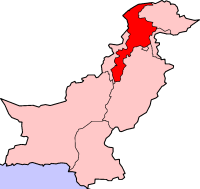
Phallus calongei is a species of stinkhorn mushroom. Found in Pakistan, it was described as new to science in 2009. Starting out as an "egg", the fully expanded fruit body consists of a single, thick, stipe with a cap attached to the apex and covered with olive-green, slimy spore-containing gleba. It is distinguished from other similar Phallus species by a combination of features, including a pinkish, reticulated (network-like) cap, and a stipe that is tapered at both ends. The edibility of the mushroom is unknown.
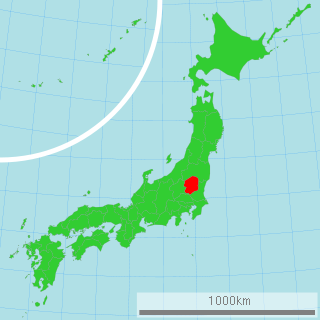
Aseroe coccinea is a species of stinkhorn fungus in the genus Aseroe. First reported in Japan in 1989, it was not formally validated as a species until 2007, the delay related to a publication error. The receptacle, or fruit body, begins as a partially buried whitish egg-shaped structure, which bursts open as a hollow white stipe with reddish arms, then erupts and grows to a height of up to 15 mm (0.6 in). It matures into a star-shaped structure with seven to nine thin reddish tubular "arms" up to 10 mm (0.4 in) long radiating from the central area. The top of the receptacle is covered with dark olive-brown spore-slime, or gleba. A. coccinea can be distinguished from the more common species A. rubra by differences in the color of the receptacle, and in the structure of the arms. The edibility of the fungus has not been reported.

Clathrus crispus is a species of fungus in the stinkhorn family. Reported as new to science in 1820, it is found in the Americas.

Colus hirudinosus is a species of stinkhorn fungus (Gasteromycete) found in Asia, Australia, northern Africa, and southern Europe. The fruit body has a short, thick stalk that divides into several spongy, wrinkled, stalk-like, orange to red columns that are united at the top, thus forming a lattice. The spores are found within the gleba—a dark, olive-brown slime that coats the inside of the columns. Spores are spread by insects that are attracted by the fetid smell of the gleba, eat the spores, and pass them on to germinate elsewhere.

Colus pusillus is a species of fungus in the family Phallaceae. It is found in Australia. It is sometimes known as the craypot stinkhorn or basket stinkhorn, a reference to the unique appearance of the fruiting bodies which consist of vivid red, wrinkled arms that branch and connect to form a cage-like structure reminiscent to that of the related species Clathrus ruber. This fungus is saprobic and makes frequent appearances on garden mulch as a result.

Rhizopogon evadens is a truffle-like fungus in the family Rhizopogonaceae. Found in North America, it was described as new to science by American mycologist Alexander H. Smith in 1966. The fungus produces roundish to irregularly shaped fruitbodies measuring 2–5 cm (0.8–2.0 in) in diameter, with irregular lobes, wrinkles and depressions on the surface. The peridium is whitish with light yellow to brown stains, and bruises red. The fungus has an unpleasant odor and a taste described as "metallic". Typical tree associates include pine, Douglas fir, and hemlock. Initially white, the gleba turn olive to olive-brown in maturity, with the contents developing a gelatinous consistency. The smooth spores of R. evadens are narrowly ellipsoid in shape, and measure 6–8 by 2–2.3 µm.




















